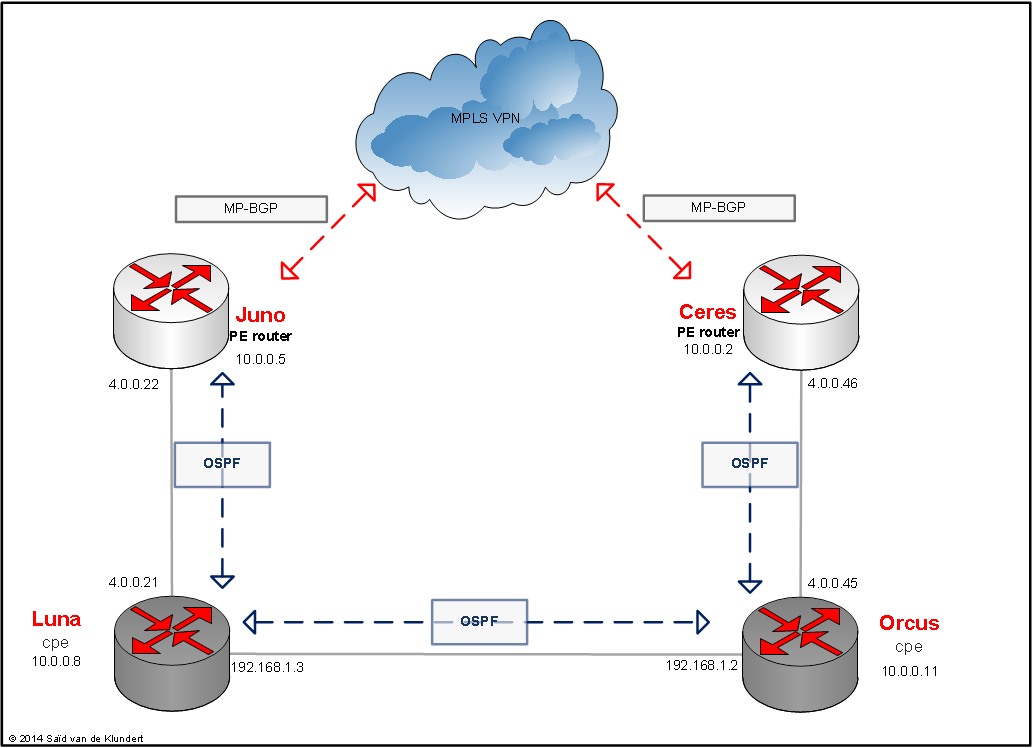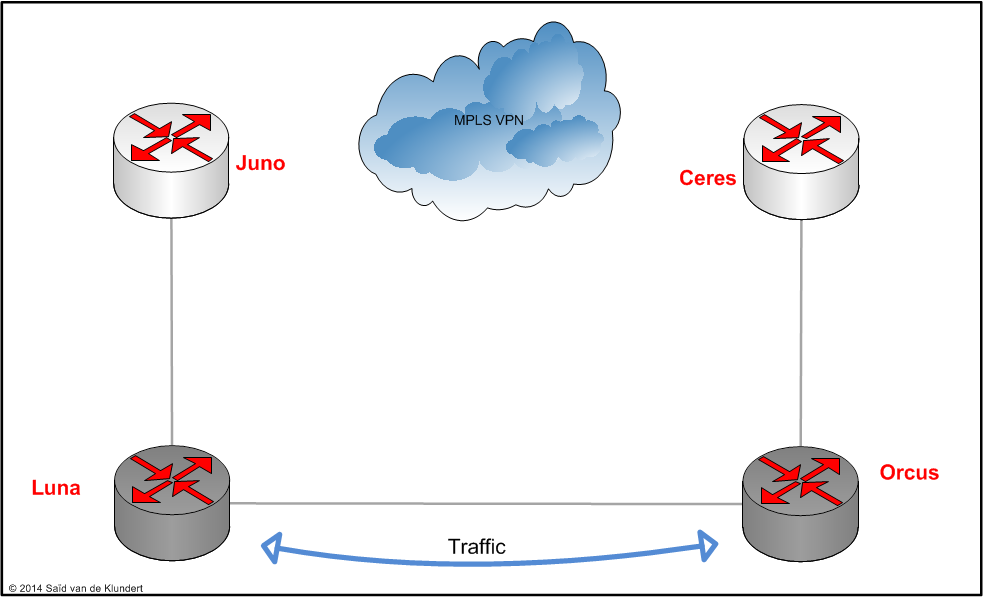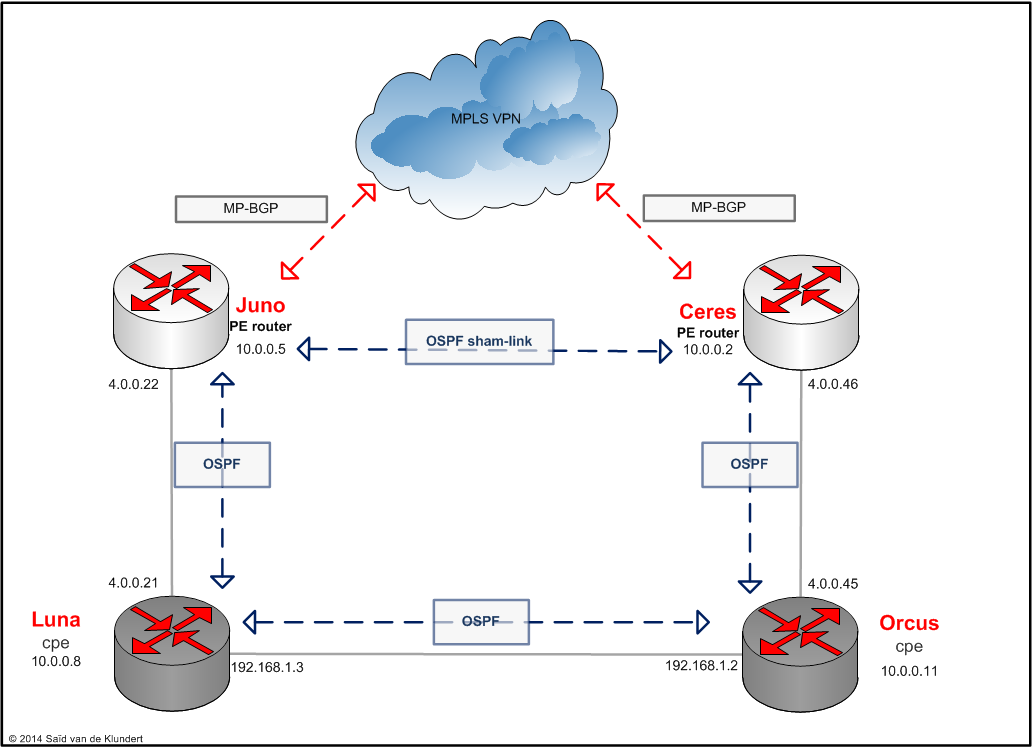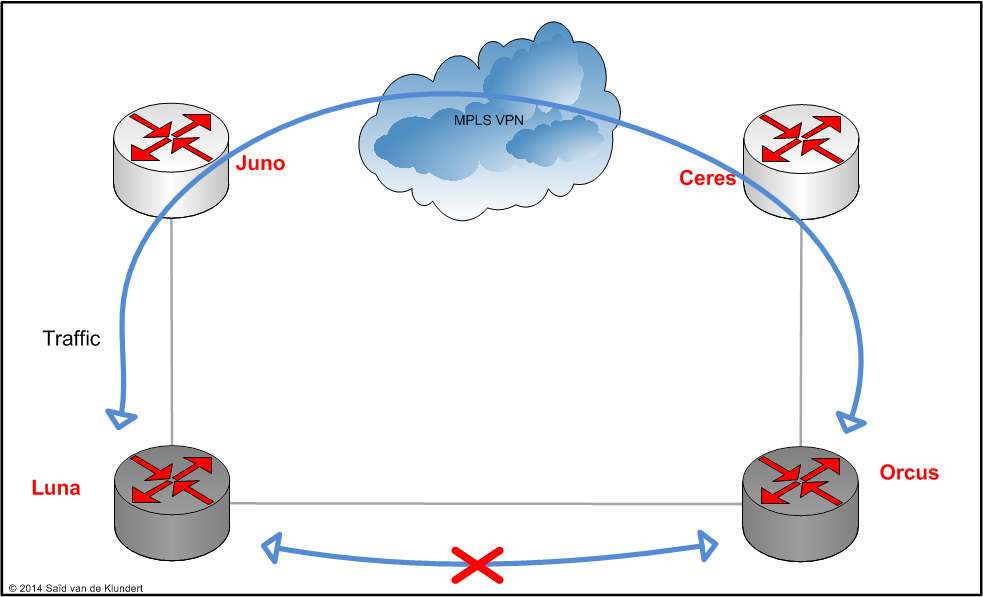This is an example on using the OSPF sham link in a BGP signaled MPLS VPN. The scenario is as follows:

In the scenario above, you can see two PE routers. These are Juno and Ceres. Both PE routers are running MP-BGP to exchange vpn routes with each other. They are also running OSPF with the CPE’s. The PE is redistributing BGP routes into OSPF.
The two CPE’s are Luna and Orcus. They do not only run OSPF with the PE they are connected to, they also run OSPF with each other. The configuration is as follows:
Juno:
set interfaces xe-2/0/1 unit 105 description LUNA set interfaces xe-2/0/1 unit 105 vlan-id 105 set interfaces xe-2/0/1 unit 105 family inet mtu 1500 set interfaces xe-2/0/1 unit 105 family inet address 4.0.0.22/30 set interfaces lo0 unit 50 description ipvpn-Juno set interfaces lo0 unit 50 family inet address 10.0.0.5/32 set policy-options policy-statement bgp-2-ospf term 1 from protocol bgp set policy-options policy-statement bgp-2-ospf term 1 then accept set policy-options policy-statement bgp-2-ospf term reject-all then reject set routing-instances ipvpn instance-type vrf set routing-instances ipvpn interface xe-2/0/1.105 set routing-instances ipvpn interface lo0.50 set routing-instances ipvpn route-distinguisher 1:1 set routing-instances ipvpn vrf-target target:1:1 set routing-instances ipvpn vrf-table-label set routing-instances ipvpn protocols ospf export bgp-2-ospf set routing-instances ipvpn protocols ospf area 0.0.0.0 interface xe-2/0/1.105 interface-type p2p set routing-instances ipvpn protocols ospf area 0.0.0.0 interface lo0.50
Ceres:
set interfaces xe-2/0/1 unit 111 description ORCUS set interfaces xe-2/0/1 unit 111 vlan-id 111 set interfaces xe-2/0/1 unit 111 family inet mtu 1500 set interfaces xe-2/0/1 unit 111 family inet address 4.0.0.46/30 set interfaces lo0 unit 20 description ipvpn-Ceres set interfaces lo0 unit 20 family inet address 10.0.0.2/32 set policy-options policy-statement bgp-2-ospf term 1 from protocol bgp set policy-options policy-statement bgp-2-ospf term 1 then accept set policy-options policy-statement bgp-2-ospf term reject-all then reject set routing-instances ipvpn instance-type vrf set routing-instances ipvpn interface xe-2/0/1.111 set routing-instances ipvpn interface lo0.20 set routing-instances ipvpn route-distinguisher 1:1 set routing-instances ipvpn vrf-target target:1:1 set routing-instances ipvpn vrf-table-label set routing-instances ipvpn protocols ospf export bgp-2-ospf set routing-instances ipvpn protocols ospf area 0.0.0.0 interface xe-2/0/1.111 interface-type p2p set routing-instances ipvpn protocols ospf area 0.0.0.0 interface lo0.20
Luna:
set interfaces xe-2/0/1 unit 150 description Orcus set interfaces xe-2/0/1 unit 150 vlan-id 150 set interfaces xe-2/0/1 unit 150 family inet mtu 1500 set interfaces xe-2/0/1 unit 150 family inet address 192.168.1.3/24 set interfaces xe-2/0/0 unit 105 description JUNO set interfaces xe-2/0/0 unit 105 vlan-id 105 set interfaces xe-2/0/0 unit 105 family inet mtu 1500 set interfaces xe-2/0/0 unit 105 family inet address 4.0.0.21/30 set interfaces lo0 unit 8 description LUNA set interfaces lo0 unit 8 family inet address 10.0.0.8/32 set protocols ospf area 0.0.0.0 interface xe-2/0/0.105 interface-type p2p set protocols ospf area 0.0.0.0 interface lo0.8 interface-type p2p set protocols ospf area 0.0.0.0 interface xe-2/0/1.150
Orcus:
set interfaces xe-2/0/0 unit 111 description CERES set interfaces xe-2/0/0 unit 111 vlan-id 111 set interfaces xe-2/0/0 unit 111 family inet mtu 1500 set interfaces xe-2/0/0 unit 111 family inet address 4.0.0.45/30 set interfaces xe-2/0/0 unit 111 family iso set interfaces xe-2/0/0 unit 150 description Luna set interfaces xe-2/0/0 unit 150 vlan-id 150 set interfaces xe-2/0/0 unit 150 family inet mtu 1500 set interfaces xe-2/0/0 unit 150 family inet address 192.168.1.2/24 set interfaces lo0 unit 11 family inet address 10.0.0.11/32 set protocols ospf area 0.0.0.0 interface lo0.11 set protocols ospf area 0.0.0.0 interface xe-2/0/0.111 interface-type p2p set protocols ospf area 0.0.0.0 interface xe-2/0/0.150
Without the use of a sham link, the CPE’s will prefer to use the link that connects them directly together when they need to send traffic to subnets advertised by either of them.

The following is a printout from Luna.
play@MX104-TEST-HB:Luna> show route 10.0.0.11
inet.0: 19 destinations, 20 routes (19 active, 0 holddown, 0 hidden)
+ = Active Route, - = Last Active, * = Both
10.0.0.11/32 *[OSPF/10] 00:01:57, metric 3
> to 192.168.1.2 via xe-2/0/1.150
play@MX104-TEST-HB:Luna> show ospf route 10.0.0.11
Topology default Route Table:
Prefix Path Route NH Metric NextHop Nexthop
Type Type Type Interface Address/LSP
10.0.0.11 Intra Router IP 3 xe-2/0/1.150 192.168.1.2
10.0.0.11/32 Intra Network IP 3 xe-2/0/1.150 192.168.1.2
This printout show that Luna will use the link it has to Orcus for all traffic destined to that router. Luna is using an intra area OSPF route.
Juno is also advertising the route towards Luna, but the route coming from Juno is not used. This has nothing to do with the metric that is associated with the route. When we deactivate OSPF on the interfaces between Orcus and Luna, we can see why the route via Juno is less attractive:
play@MX104-TEST-HB:Luna> show route 10.0.0.11
inet.0: 17 destinations, 19 routes (17 active, 0 holddown, 0 hidden)
+ = Active Route, - = Last Active, * = Both
10.0.0.11/32 *[OSPF/10] 00:01:45, metric 2
> to 4.0.0.22 via xe-2/0/0.105
play@MX104-TEST-HB:Luna> show ospf route 10.0.0.11
Topology default Route Table:
Prefix Path Route NH Metric NextHop Nexthop
Type Type Type Interface Address/LSP
10.0.0.11/32 Inter Network IP 2 xe-2/0/0.105 4.0.0.22
As soon as the OSPF adjacency between Luna an Orcus is lost, the route via Juno is installed (the next-hop changed from 192.168.1.2 to 4.0.0.22). As you can see, this route is an inter area OSPF route.
In OSPF, intra area routes are routes that are originating from within the same area. This is the case for routes learned from Orcus. Inter area routes are routes that originated outside the area and were advertised into the area.
In our case, the fact that Ceres and Juno are running OSPF in area 0 is not relevant. The PE’s use BGP to update each other with this routing information, so Juno learned the route via MP-BGP and redistributed the route into OSPF. This makes it an inter area route. OSPF will always prefer an intra area route over an inter area route, this is regardless of the metric that is associated with that route.
The sham link is an unnumbered point-to-point link inside a routing-instance between two PE routers. Across the sham link, the PE routers can build an OSPF adjacency directly with each other. Because they can build the OSPF adjacency directly with each other, the routes exchanged between the PE's will remain intra area routes. This as opposed to having to redistribute routing information from BGP into OSPF. Thus, by using the sham link, we can make the CPE’s use the link they have with the PE routers and make them send all traffic through the MPLS VPN.

To configure the sham link in our scenario, we need to add the following configuration:
Juno:
set routing-instances ipvpn protocols ospf sham-link local 10.0.0.5 set routing-instances ipvpn protocols ospf area 0.0.0.0 sham-link-remote 10.0.0.2 metric 1
Ceres:
set routing-instances ipvpn protocols ospf sham-link local 10.0.0.2 set routing-instances ipvpn protocols ospf area 0.0.0.0 sham-link-remote 10.0.0.5 metric 1
After the configuration of this sham link, we can use the following commands to verify our configuration:
play@MX104-TEST-HB:Juno> show ospf neighbor instance ipvpn Address Interface State ID Pri Dead 10.0.0.2 shamlink.0 Full 10.0.0.2 0 34 4.0.0.21 xe-2/0/1.105 Full 10.0.0.8 128 39 play@MX104-TEST-HB:Juno> show ospf interface shamlink.0 extensive instance ipvpn Interface State Area DR ID BDR ID Nbrs shamlink.0 PtToPt 0.0.0.0 0.0.0.0 0.0.0.0 1 Type: P2P, Address: 0.0.0.0, Mask: 0.0.0.0, MTU: 0, Cost: 1 Local: 10.0.0.5, Remote: 10.0.0.2 Adj count: 1 Hello: 10, Dead: 40, ReXmit: 5, Not Stub Auth type: None Protection type: None, No eligible backup Topology default (ID 0) -> Cost: 1
This is a direct neighbor relationship in area 0.0.0.0. When we move to Luna, we can see that the route learned via Juno is now an intra area route:
play@MX104-TEST-HB:Luna> show ospf route 10.0.0.11
Topology default Route Table:
Prefix Path Route NH Metric NextHop Nexthop
Type Type Type Interface Address/LSP
10.0.0.11 Intra Router IP 3 xe-2/0/1.150 192.168.1.2
xe-2/0/0.105 4.0.0.22
10.0.0.11/32 Intra Network IP 3 xe-2/0/1.150 192.168.1.2
xe-2/0/0.105 4.0.0.22
Both routes are now intra area routes and they are contending based on their metric. When we increase the cost of the direct link to 4, we can see the following:
play@MX104-TEST-HB:Luna> configure
Entering configuration mode
[edit]
play@MX104-TEST-HB:Luna# set protocols ospf area 0.0.0.0 interface xe-2/0/1.150 metric 4
[edit]
play@MX104-TEST-HB:Luna# commit and-quit
commit complete
Exiting configuration mode
play@MX104-TEST-HB:Luna> show route 10.0.0.11
inet.0: 19 destinations, 21 routes (19 active, 0 holddown, 0 hidden)
+ = Active Route, - = Last Active, * = Both
10.0.0.11/32 *[OSPF/10] 00:00:07, metric 3
> to 4.0.0.22 via xe-2/0/0.105
Let’s apply the same metric for the link on the Orcus router:
play@MX104-TEST-HB:Orcus> configure
Entering configuration mode
[edit]
play@MX104-TEST-HB:Orcus# set protocols ospf area 0.0.0.0 interface xe-2/0/0.150 metric 4
[edit]
play@MX104-TEST-HB:Orcus# commit and-quit
show rou 10.0.0.8
commit complete
Exiting configuration mode
play@MX104-TEST-HB:Orcus> show route 10.0.0.8
inet.0: 20 destinations, 20 routes (20 active, 0 holddown, 0 hidden)
+ = Active Route, - = Last Active, * = Both
10.0.0.8/32 *[OSPF/10] 00:00:04, metric 3
> to 4.0.0.46 via xe-2/0/0.111
Instead of using the link with each other, traffic will now be sent across the MPLS VPN.

The relevant configuration with the sham link:
Juno:
set interfaces xe-2/0/1 unit 105 description LUNA set interfaces xe-2/0/1 unit 105 vlan-id 105 set interfaces xe-2/0/1 unit 105 family inet mtu 1500 set interfaces xe-2/0/1 unit 105 family inet address 4.0.0.22/30 set interfaces lo0 unit 50 description ipvpn-Juno set interfaces lo0 unit 50 family inet address 10.0.0.5/32 set policy-options policy-statement bgp-2-ospf term 1 from protocol bgp set policy-options policy-statement bgp-2-ospf term 1 then accept set policy-options policy-statement bgp-2-ospf term reject-all then reject set routing-instances ipvpn instance-type vrf set routing-instances ipvpn interface xe-2/0/1.105 set routing-instances ipvpn interface lo0.50 set routing-instances ipvpn route-distinguisher 1:1 set routing-instances ipvpn vrf-target target:1:1 set routing-instances ipvpn vrf-table-label set routing-instances ipvpn protocols ospf export bgp-2-ospf set routing-instances ipvpn protocols ospf sham-link local 10.0.0.5 set routing-instances ipvpn protocols ospf area 0.0.0.0 sham-link-remote 10.0.0.2 metric 1 set routing-instances ipvpn protocols ospf area 0.0.0.0 interface xe-2/0/1.105 interface-type p2p set routing-instances ipvpn protocols ospf area 0.0.0.0 interface lo0.50
Ceres:
set interfaces xe-2/0/1 unit 111 description ORCUS set interfaces xe-2/0/1 unit 111 vlan-id 111 set interfaces xe-2/0/1 unit 111 family inet mtu 1500 set interfaces xe-2/0/1 unit 111 family inet address 4.0.0.46/30 set interfaces lo0 unit 20 description ipvpn-Ceres set interfaces lo0 unit 20 family inet address 10.0.0.2/32 set policy-options policy-statement bgp-2-ospf term 1 from protocol bgp set policy-options policy-statement bgp-2-ospf term 1 then accept set policy-options policy-statement bgp-2-ospf term reject-all then reject set routing-instances ipvpn instance-type vrf set routing-instances ipvpn interface xe-2/0/1.111 set routing-instances ipvpn interface lo0.20 set routing-instances ipvpn route-distinguisher 1:1 set routing-instances ipvpn vrf-target target:1:1 set routing-instances ipvpn vrf-table-label set routing-instances ipvpn protocols ospf export bgp-2-ospf set routing-instances ipvpn protocols ospf sham-link local 10.0.0.2 set routing-instances ipvpn protocols ospf area 0.0.0.0 sham-link-remote 10.0.0.5 metric 1 set routing-instances ipvpn protocols ospf area 0.0.0.0 interface xe-2/0/1.111 interface-type p2p set routing-instances ipvpn protocols ospf area 0.0.0.0 interface lo0.20
Luna:
set interfaces xe-2/0/1 unit 150 description Orcus set interfaces xe-2/0/1 unit 150 vlan-id 150 set interfaces xe-2/0/1 unit 150 family inet mtu 1500 set interfaces xe-2/0/1 unit 150 family inet address 192.168.1.3/24 set interfaces xe-2/0/0 unit 105 description JUNO set interfaces xe-2/0/0 unit 105 vlan-id 105 set interfaces xe-2/0/0 unit 105 family inet mtu 1500 set interfaces xe-2/0/0 unit 105 family inet address 4.0.0.21/30 set interfaces lo0 unit 8 description LUNA set interfaces lo0 unit 8 family inet address 10.0.0.8/32 set protocols ospf area 0.0.0.0 interface xe-2/0/0.105 interface-type p2p set protocols ospf area 0.0.0.0 interface lo0.8 interface-type p2p set protocols ospf area 0.0.0.0 interface xe-2/0/1.150 metric 4
Orcus:
set interfaces xe-2/0/0 unit 111 description CERES set interfaces xe-2/0/0 unit 111 vlan-id 111 set interfaces xe-2/0/0 unit 111 family inet mtu 1500 set interfaces xe-2/0/0 unit 111 family inet address 4.0.0.45/30 set interfaces xe-2/0/0 unit 111 family iso set interfaces xe-2/0/0 unit 150 description Luna set interfaces xe-2/0/0 unit 150 vlan-id 150 set interfaces xe-2/0/0 unit 150 family inet mtu 1500 set interfaces xe-2/0/0 unit 150 family inet address 192.168.1.2/24 set interfaces lo0 unit 11 family inet address 10.0.0.11/32 set protocols ospf area 0.0.0.0 interface lo0.11 set protocols ospf area 0.0.0.0 interface xe-2/0/0.111 interface-type p2p set protocols ospf area 0.0.0.0 interface xe-2/0/0.150 metric 4